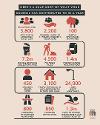How the budget works

The council's budget is divided into two main areas - revenue and capital.
Revenue Budget
The council's revenue budget relates to the day-to-day expenditure for the delivery of essential services, that most people use. These include:

Council budgets are funded through a variety of different revenue streams. With significant funding cuts from Central Government over the last 14 years, council tax and business rates income have become increasingly vital sources of revenue for local authorities. The new government has recognised the challenges faced by local authorities and is providing additional resources which will help to address the significant demand pressures, particularly within Children and Adult Social Care.


Capital Budget
The council's indicative capital programme is approximately £150 million over the next two years. This programme represents significant investment in the borough, including over £80 million dedicated to the regeneration of St Helens Town Centre including the construction of the Town's new, modern multi-modal transport interchange.
Currently, the council has budgeted to spend £146 million in 2024/25, with substantial investments in local transport networks and town centres.
The council cannot use capital funds for daily operations due to government rules. The video above explains the difference between revenue and capital budgets in more detail.

Setting a Balanced Budget
The final budget-setting report, the 'Medium Term Financial Strategy 2025-2028 and Revenue & Capital Budget 2025/26', was approved by Cabinet on the 26 February 2025 and by full Council on 5 March 2025.
A copy of the 'Medium Term Financial Strategy 2025-2028 and Revenue & Capital Budget 2025/26' report can be found under 'Downloads' below.




